Clash of Titans
Games featuring a future Hall of Fame coach on each sideline.
November 22, 1924: Stanford @ California
Glenn "Pop" Warner vs Andy Smith
Glenn "Pop" Warner called this game "my greatest day in football." The former coach of Carlisle and Pittsburgh wrote:
I came to Stanford as head coach with a tough job ahead of me. Stanford was weak, woefully weak, and had been the doormat of the Pacific Coast Conference for some time. The year 1924 was my first year there and it was my misfortune to arrive at a time when California was ruling the roost with its "Wonder Team" as the writers called it. Under the able coaching of Andy Smith, the old Penn fullback, California had consistently beaten Stanford in their "Big Game." Naturally, we wanted to win against the Bears, and I don't think a team took the field with a stronger motive, or greater desire for victory than this Stanford team of 1924.
Andy Smith had never had a losing season at California since he took over in 1916. From 1920-23, his Cal teams won 36 games, lost none, and tied two. They defeated Ohio State in the 1920 Rose Bowl 28-0 and played a scoreless tie against Washington and Jefferson in Pasadena the next season.
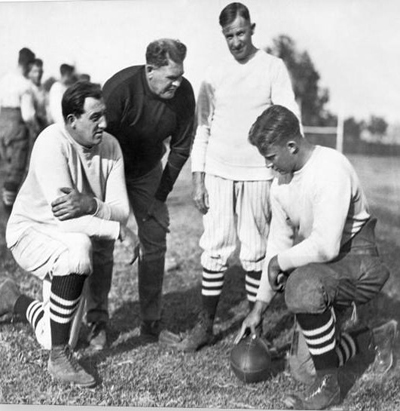
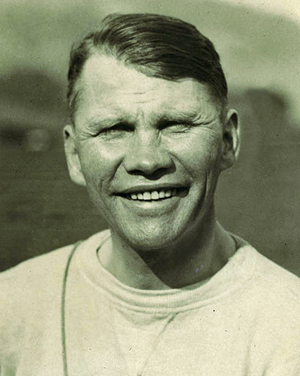
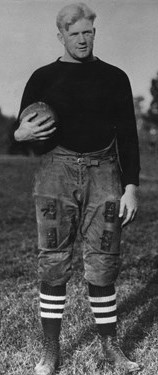
Stanford Coaching Staff: L-R: Tiny Thornhill, Pop Warner, Andy Kerr, and Stanford captain Jim Lawson
M: California coach Andy Smith; R: Ernie Nevers
The two Bay Area rivals entered the game with impressive records: 7-0 for Stanford and 7-0-1 for Cal. The Cardinal had outscored opponents 149-22 while the Bears had compiled a 128-31 advantage over their foes. Cal was favored by 14 points based on their tougher schedule.
The opposing coaches had contrasting coaching philosophies. "Carry the ball and keep on carrying it," said Warner. "The best defense is a strong offense." Smith believed, "Kick the ball and keep on kicking it. The team that gets the breaks will win."
Both teams would compete without a star player. Stanford's junior FB Ernie Nevers was rated the Pacific Coast's best player in both football and basketball as well as an outstanding pitcher and a leading track performer. In a scrimmage before the first game of the season, he broke his ankle and was lost for the first six games. Stanford won them all. Ernie returned for the seventh game against Montana, but the hard-luck fullback broke his other ankle and was sidelined for the rest of the regular season.
Warner lost his fastest back in a much different manner. Two days prior to the game, the Stanford Faculty Athletic Committee declared Norman Cleaveland ineligible. Entering a game in 1921 for a few plays cost him a season of eligibility. Stanford offered to forfeit its 1924 conference victories, but the opponents declined the offer. However, the furor was terrific because Cardinal officials, alumni, coaches, and players felt California had this information for weeks but deliberately waited until 48 hours before the kickoff to complicate Stanford's preparation for the game.
So the "Old Man" (as Warner was dubbed) went into his first Big Game with two strikes against him. Jim Kelley, "big, powerful, but not very fast," would take Cleaveland's place at right halfback. Fortunately, the Stanford forward wall was solid, tough, and capable. The six linemen would all play the full 60 minutes against Cal as Warner employed only 16 players.

California's new Memorial Stadium for the 1924 Big Game
(Stanford University Quad Yearbook Class of 1926)
The game was played in Cal's new 73,000-seat Memorial Stadium, which had opened late in the previous season. A record crowd of 77,000 jammed the stadium with several thousands more watching from "tightwad hill." The Oakland Tribune reported that scalpers were getting $100 for a pair of tickets.
The first quarter gave no indication of the excitement to come. Neither team came close to scoring in the first period, which devolved into a punting duel between Murray Cuddeback of Stanford and Jim Dixon of Cal.
Stanford Kicks Field Goals
Stanford finally starting moving the ball on their first possession of the second period. Captain Jim Lawson gained 16 on a "tricky reverse play," and suddenly the Cardinal were at midfield. Then Cliff Hey passed to E Ted Shipkey for 20y. Staying on the ground, the Cardinal marched to the six before running out of steam. So Cuddeback kicked a field goal. Stanford 3 California 0
A few minutes later, Cuddeback intercepted a pass and returned it into Cal territory. Two completions for 28y put the ball on the nine. But on fourth-and-goal from the three, an incomplete pass turned the ball over to the Bears.
Stanford soon had the ball back at midfield. On fourth down, Cuddeback lined up for a field goal from the 43. With many expecting a fake, the rangy halfback's toe sent the ball sailing through the uprights. Stanford 6 California 0 at halftime
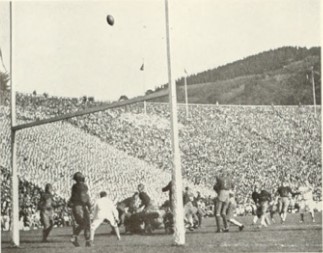

L: Murray Cuddeback's first field goal; R: Cuddeback's second field goal
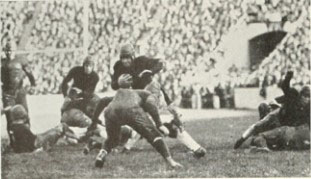
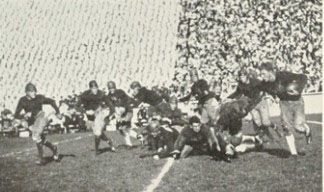
L: Cliff Hey gains through Cal line. R: Lawson embarks on long end run.
(Stanford University Quad Yearbook Class of 1926)
Bears Roar Back
Coach Smith's halftime talk must have been a doozy because Cal came back furiously after the break. Starting from the 19 after the kickoff, James Dixon ran for 13. Then Talma Imlay tore through the whole Stanford team for 47y to put the pigskin on the eight. Bert Griffin scored from there, and Glenn Carlson's drop-kick conversion gave Cal the lead, 7-6.
After forcing a quick punt, the Bears continued their rampage. After Griffin zipped for 28, three passes moved the ball deep into Cal territory. Soon after the final period began, with the ball on the Stanford 16, Dixon passed to Imlay, who dodged, twisted, squirmed, and fought his way into the end zone for the Bears' second touchdown. Carlson again converted. California 14 Stanford 6
 Helmetless James Dixon gains 5y off tackle for California. |
 Talma Imlay 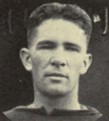 James Dixon |
University of California Blue and Gold Yearbook Class of 1925 | |

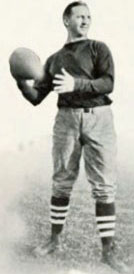
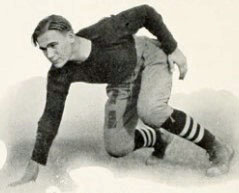
L-R: Murray Cuddeback, Edgar Walker, Ted Shipkey
(Stanford University Quad Yearbook Class of 1926)
Cardinal Finish Strong
The team that scored could choose to receive the ensuing kickoff, and that's what Cal did. The move didn't payoff right away as the Cardinal defense forced a three-and-out. But Howard Mitchell fumbled Myron Brown's bounding punt, and John Sargent recovered for the Bears on the Stanford 29.
After John Clymer gained 3y at left end, Bert Griffin ran twice for a first down at the 18. He then zipped through right guard unmolested for the touchdown. This time Carlson's dropkick went wide, a mistake that would cost the Bears the victory. California 20 Stanford 6
Cal again received the kickoff, but a 15y holding penalty cut their possession short. This time Fred Solomon took the punt and returned 24y to the Bears 41.
Walter Camp, the #1 recognized football authority in the nation who had coached Stanford in 1892, was on the Cal sideline congratulating the apparent winners.
With less than six minutes left, Coach Smith, apparently thinking the 14-point margin was a safe one, took out his two top backs, Dixon and Imlay, both battered and bruised. Under the rules of the day, that meant neither could return to the game since this was the final quarter. They were replaced by Clymer and Brown. On the other sideline, Warner substituted sophomore Edgar Walker at halfback and put Solomon back in. Both immediately made their presence felt.
Warner had been repeatedly criticized during the season by one San Francisco newspaper for using Walker too much. He was big and strong but clumsy in appearance. But needing to pass to have a chance to tie, the "Old Man" took a chance that paid off.
After an incompletion, Walker connected with Solomon for 26y, Frank Thatcher downing Solomon from behind on the Cal 15. But Griffin dropped Cuddeback for a loss of 7y. Lawson gained 4y on a "criss-cross" around right end. Then Walker threw an 18y pass to Shipkey in the end zone, and the deficit was cut in half when Cuddeback converted. California 20 Stanford 13 with four minutes to play.
Now Stanford benefitted from the kickoff rule, but their possession didn't last long. On third and long, Walker's pass was intercepted by Brown on the Cal 48.
In a move that is unfathomable to us today, the Bears ran just one play, then punted! But Brown's kick traveled 50y to Solomon, who returned 10y to the Stanford 15 with less than three minutes remaining.
At this point, one of Warner's key backs, Cuddeback, was recuperating on the sideline after crashing into a movie camera that was too close to the sideline. But he was soon revived and back in the game for the final push.
The prevailing wisdom dictated that you didn't take a chance on passing the ball from deep in your territory lest it be intercepted. So Hey faked a pass and ran through left tackle for 7y. Then he hit right guard for a first down on the 26.
Two runs for a total of 4y preceded the play of the day. Hey passed to Shipkey for 43y to the Cal 37 where John Young tackled him. Now the Bear fans were getting nervous. After George Bogue went in at fullback for Stanford and gained 2y, Thatcher broke through and smeared Cuddeback's attempted forward pass at the 35. Just when Cal was regaining some confidence, lightning struck again. Walker threw to Cuddeback. He caught the ball at the 15 and ran into the end zone with less than a minute to play. Cuddeback calmly booted the crucial PAT–his 14th point of the day–to tie the game at 20. FINAL SCORE: CALIFORNIA 20 STANFORD 20
Despite ending in a deadlock that kept the series even at 12-12-6, the game was widely considered at that time and for many years afterward as one of the most exciting in West Coast football history. The Bears ended their fifth straight season without a loss.
Their Cinderella unbeaten season earned the Cardinal an invitation to the Rose Bowl to play Notre Dame. Read about that game...
References
66 Years on the California Gridiron 1882-1948: The History of Football at the University of California, S. Dan Brodie (1949)
The Color of Life Is Red: A History of Stanford Athletics 1892-1972, Don E. Liebendorfer (1972)
Cal–Stanford, The Big Game: A game-by-game history of America’s greatest football rivalry, John T. Sullivan (1982)
66 Years on the California Gridiron 1882-1948: The History of Football at the University of California, S. Dan Brodie (1949)
The Color of Life Is Red: A History of Stanford Athletics 1892-1972, Don E. Liebendorfer (1972)
Cal–Stanford, The Big Game: A game-by-game history of America’s greatest football rivalry, John T. Sullivan (1982)